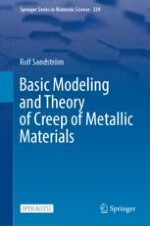7.1 General
7.2 Previous Models for the Influence of Particles on the Creep Strength
7.2.1 Threshold Stress
7.2.2 Orowan Model
7.2.3 The Role of the Energy Barrier
7.3 Precipitation Hardening Based on Time Control
-
Precipitation hardening is considered but not oxide dispersion strengthening (ODS). This means that the attractive interaction that sometimes appears for ODS alloys is not taken into account.
-
The controlling mechanism is assumed to be the time it takes for a dislocation to climb across a particle, not an energy barrier. It is this time that decides whether a particle will be climbed or not.
-
The critical particles radius rcrit is taken for the largest particle where there is sufficient time for the dislocation to climb across.
-
For particles smaller than rcrit they will freely be climbed across and will not contribute to the creep strength.
-
Particle shearing is not taken into account since small particles will be passed by climb anyway.
-
Particles larger than rcrit have to be passed by Orowan bowing and this determines their contribution to the creep strength.
7.4 Application of the Precipitation Hardening Model
7.4.1 Analyzed Materials
Co, wt.% | Heat treatment temperature, °C | Heat treatment type | Particle volume fraction | Co in solid solution, wt.% | Particle radius, nm | Particle spacing, nm | Orowan stress, MPa |
|---|---|---|---|---|---|---|---|
0.88 | 600 | Underaged | 0.00567 | 0.33 | 1.2 | 41 | 593 |
0.88 | 600 | Aged | 0.00567 | 0.33 | 4.2 | 98 | 250 |
0.88 | 600 | Overaged | 0.00567 | 0.33 | 17.2 | 405 | 60 |
2.48 | 600 | Aged | 0.0222 | 0.33 | 7.6 | 90 | 272 |
4.04 | 700* | Aged | 0.0344 | 0.33* | 22.6 | 215 | 113 |
7.4.2 Pure Copper
7.4.3 Cu–Co Alloys
7.5 Summary
-
Empirical models for the influence of particles on the creep strength have often simply used the Orowan model. This has the consequence that the strong temperature dependence is almost completely neglected and hardening effect is exaggerated.
-
Traditional systematic models for precipitation hardening during creep have been based on energy barriers. However, assessment of the size of the energy barriers has shown that it is negligibly small. Instead the modeling in this chapter is starting from the assumption that the time it takes for a particle to be climbed is the factor that controls if the particle contributes to the creep strength or not.
-
A critical particle size is introduced. Particles that are smaller than the critical size do not contribute to the creep strength. Particles larger than the critical size must pass particles by Orowan bowing and they contribute to the creep strength.
-
To find the critical particle size, the particle size distribution must be known. Exponential size distributions have been assumed. Such distributions have been found a number of times for creep resistant steels.
-
A critical test has been performed for Cu–Co alloys. This is a suitable system since the amount of solid solution hardening is quite small. The model can account for the reduction in creep rate due to the presence of Co particles in Cu.
-
Observed effects of Co content, heat treatment condition and stress dependence on the creep rate can be satisfactorily reproduced.
-
The predicted increase in the creep strength is significantly smaller than the Orowan strength (except at high stress and high alloy content). The ratio between the predicted increase in strength and the Orowan strength varies with applied stress, Co-content and ageing condition.
